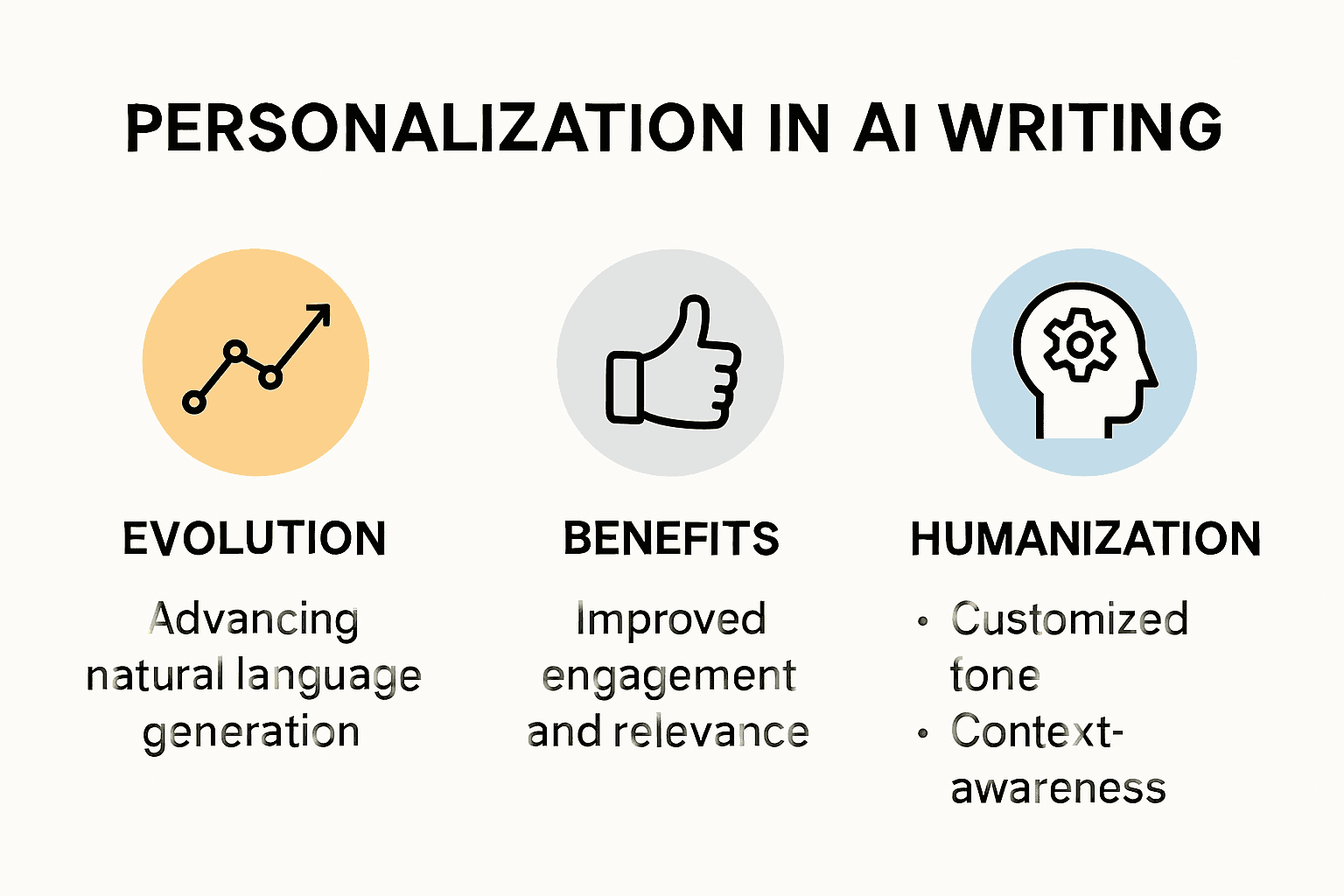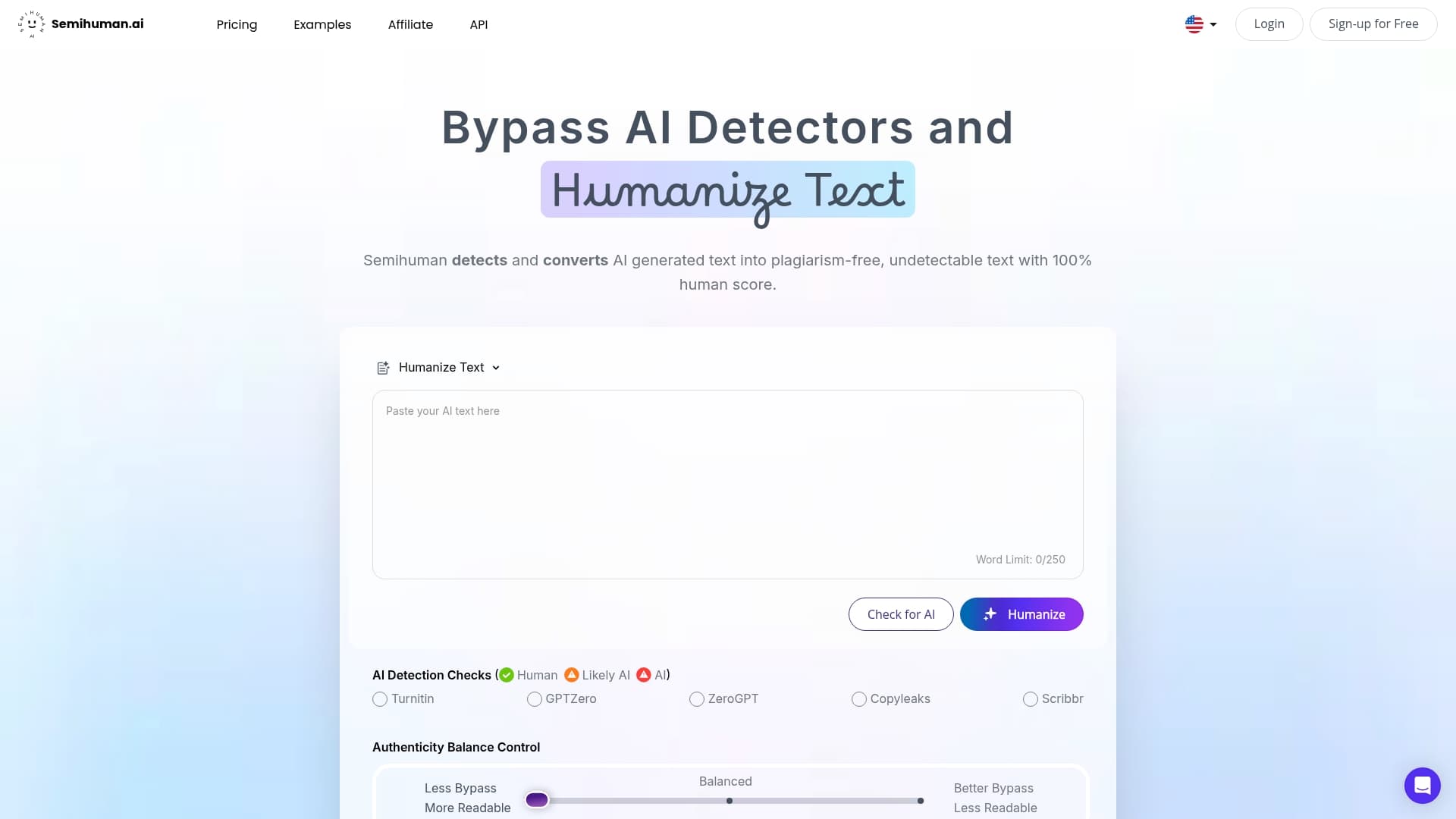Blog
Learning Materials
Personalisatie in schrijven met kunstmatige intelligentie: Strategieën voor succesvolle content in 2025
Updated: June 29, 2025

Personalized AI-content is niet zomaar een modewoord. Het verandert volledig hoe merken en makers online met mensen in contact komen. Hier is een statistiek die de wenkbrauwen zal doen fronsen. Organisaties die geavanceerde AI-personalisatie gebruiken, genereren nu 40 procent meer omzet dan degenen die vasthouden aan ouderwetse benaderingen. Je zou kunnen denken dat personalisatie alleen betekent dat je een voornaam invoegt of een kopregel verwisselt, maar het echte verhaal gaat dieper. Moderne AI leert nu van gedrag, past toon en stijl direct aan en voorspelt zelfs wat lezers vervolgens willen voordat ze erom vragen. De toekomst van content voelt minder als marketing en meer als een één-op-één gesprek dat je echt begrijpt. Dit nieuwe tijdperk gaat veel verder dan wat iemand had verwacht.
Inhoudsopgave
- Verbeterde Betrokkenheid door Precieze Targeting
- Operationele Efficiëntie en Prestatieoptimalisatie
- Strategische Contentintelligentie
- Doorbreken van Voorspelbare AI-Schrijfpatronen
- Strategische Contenthumanisatietechnieken
- Handmatige Beoordeling en Verfijning
- Dynamische Micro-Personalisatietechnologieën
- Marktgroei en Technologische Convergentie
- Revolutie in Klantinteractie
Korte Samenvatting
| Conclusie | Uitleg |
|---|---|
| Dynamische Personalisatie is de Sleutel | AI-schrijfpersonalisatie heeft zich ontwikkeld om real-time data en contextueel begrip te benutten, waardoor echt op maat gemaakte contentervaringen mogelijk zijn die de gebruikersbetrokkenheid verbeteren. |
| Omarm Strategische Contentintelligentie | Marketeers zouden AI-gedreven inzichten moeten gebruiken om relevante, op gedrag gebaseerde communicatiestrategieën te creëren die resoneren met doelgroepen, weg van traditionele demografische segmentatie. |
| Incorporeer Humanisatietechnieken | Om onopspoorbare AI-gegeneerde content te produceren, moeten schrijvers voorspelbare patronen doorbreken en opzettelijke variabiliteit introduceren, zodat de tekst uniek en authentiek menselijk aanvoelt. |
| Focus op Micro-Personalisatie | Naarmate AI-technologie vordert, kan het aannemen van dynamische micro-personalisatie de gebruikersbetrokkenheid aanzienlijk verbeteren door behoeften te anticiperen en content in real-time aan te passen op basis van emotionele en contextuele signalen. |

Wat Personalisatie in AI-Schrijven Vandaag Betekent
Personalisatie in AI-schrijven is getransformeerd van een eenvoudige targetingbenadering naar een verfijnde, data-gedreven strategie die contentcreatie en gebruikersbetrokkenheid hervormt. In de kern vertegenwoordigt personalisatie nu een dynamische kruising van kunstmatige intelligentie, gebruikersdata en contextueel begrip.
De Evolutie van AI-Gedreven Contentaanpassing
De personalisatie van vandaag gaat veel verder dan basis demografische segmentatie. Lees meer over geavanceerde AI-contenttechnieken die complexe algoritmen gebruiken om individueel gebruikersgedrag, voorkeuren en interactiepatronen te analyseren. Volgens IBMs onderzoek verwacht 71% van de consumenten nu dat bedrijven gepersonaliseerde contentervaringen leveren die echt zijn afgestemd op hun unieke behoeften.
AI-schrijfpersonalisatie integreert nu meerdere geavanceerde datapunten, waaronder:
- Gedragsvolging: Analyseren van real-time gebruikersinteracties
- Voorspellende Analyse: Voorkeuren van gebruikers voorspellen voordat expliciete verzoeken worden gedaan
- Contextueel Begrip: Aanpassen van contenttoon, complexiteit en stijl
Om de belangrijkste datapunten die worden gebruikt in moderne AI-personalisatie te verduidelijken, hier is een samenvattingstabel:
| Personalisatie Datapunt | Beschrijving |
|---|---|
| Gedragsvolging | Analyseren van real-time gebruikersinteracties |
| Voorspellende Analyse | Voorkeuren van gebruikers voorspellen voordat expliciete verzoeken worden gedaan |
| Contextueel Begrip | Aanpassen van contenttoon, complexiteit en stijl |
Precisie en Adaptieve Contentgeneratie
Moderne AI-schrijfpersonalisatie vertegenwoordigt een kwantumsprong in contentcreatie. Lumen Altas onderzoek onthult dat organisaties die geavanceerde personalisatiestrategieën gebruiken 40% meer omzet genereren in vergelijking met traditionele contentbenaderingen. Dit gaat niet alleen over het invoegen van een gebruikersnaam in een sjabloon—het gaat over het creëren van dynamisch gegenereerde content die uniek aanvoelt voor elk individu.
De technologie stelt schrijvers en contentmakers nu in staat om tekst te genereren die zich in real-time aanpast, rekening houdend met factoren zoals leesniveau, professionele achtergrond, culturele context en zelfs emotionele toestand. Deze hyper-gepersonaliseerde benadering transformeert generieke content in zeer boeiende, relevante ervaringen die diep resoneren met individuele lezers.

Naarmate AI zich blijft ontwikkelen, zal personalisatie steeds genuanceerder worden. De toekomst van content gaat niet over het uitzenden van boodschappen—het gaat over het creëren van intieme, responsieve communicatie die authentiek menselijk aanvoelt, ondanks dat het wordt aangedreven door geavanceerde machine learning-algoritmen.
De implicaties zijn diepgaand: content die je begrijpt, je taal spreekt en je behoeften anticipeert voordat je ze zelfs maar uitspreekt. Personalisatie in AI-schrijven is niet alleen een technologische vooruitgang—het is een fundamentele herziening van hoe we communiceren en informatie consumeren in het digitale tijdperk.
Belangrijke Voordelen voor Marketeers en Contentmakers
AI-gedreven personalisatie vertegenwoordigt een transformatieve kans voor marketeers en contentmakers, met ongekende mogelijkheden om contact te maken met doelgroepen via zeer gerichte, adaptieve contentstrategieën. Het landschap van digitale communicatie evolueert snel, waarbij intelligente personalisatie een cruciaal concurrentievoordeel wordt.
Verbeterde Betrokkenheid door Precieze Targeting
Marketeers hebben nu toegang tot geavanceerde tools die de interactie met het publiek drastisch verbeteren. Onderzoek van Harvards Digital Learning Platform geeft aan dat AI-gedreven personalisatie hypergerichte campagnes mogelijk maakt die de klantbetrokkenheid en loyaliteit aanzienlijk verhogen. Ontdek geavanceerde contentoptimalisatietechnieken die je contentstrategie kunnen revolutioneren.
Belangrijke betrokkenheidsvoordelen zijn onder andere:
- Contextuele Relevantie: Content leveren die precies is afgestemd op individuele gebruikersinteresses
- Dynamische Contentaanpassing: Real-time aanpassingen op basis van gebruikersgedrag
- Verhoogde Interactieratios: Meer betekenisvolle en gepersonaliseerde communicatie-ervaringen
Om de belangrijkste voordelen van AI-gedreven personalisatie voor marketeers en contentmakers te organiseren, zie de samenvattingstabel hieronder:
| Voordeel | Beschrijving |
|---|---|
| Contextuele Relevantie | Content komt overeen met individuele gebruikersinteresses |
| Dynamische Contentaanpassing | Real-time veranderingen op basis van gebruikersgedrag |
| Verhoogde Interactieratios | Meer betekenisvolle en gepersonaliseerde communicatie |
| Geautomatiseerde Contentgeneratie | Gestroomlijnde, schaalbare contentcreatie |
| Precieze Targeting | Zeer gerichte marketingboodschappen |
| Verbeterde Conversie & Retentie | Hogere klantbetrokkenheid en loyaliteit |
Operationele Efficiëntie en Prestatieoptimalisatie
Invocas marketingonderzoek onthult dat marketeers die AI-gedreven personalisatie gebruiken dramatische verbeteringen ervaren in kritieke prestatiestatistieken. Organisaties kunnen nu complexe contentcreatieprocessen automatiseren terwijl ze een hoge mate van individuele aanpassing behouden.
De prestatievoordelen strekken zich uit over meerdere dimensies:
- Geautomatiseerde contentgeneratie
- Precieze targeting van marketingboodschappen
- Verminderde handmatige contentoptimalisatie-inspanningen
- Verbeterde conversie- en retentieratios
Strategische Contentintelligentie
Power Digital Marketings analyse toont aan dat AI-tools e-mailmarketing en contentstrategieën transformeren door gedrag-gebaseerde personalisatie. Deze intelligente systemen analyseren enorme datasets om inzichten te genereren die marketeers in staat stellen om meer betekenisvolle, resonante ervaringen te creëren.
Door individuele gebruikersvoorkeuren, gedragspatronen en betrokkenheidsgeschiedenissen te begrijpen, kunnen contentmakers verhalen creëren die intiem op maat aanvoelen. Deze benadering gaat verder dan traditionele demografische segmentatie en creëert een meer genuanceerd en responsief communicatie-ecosysteem.
De toekomst van marketing gaat niet over het uitzenden van boodschappen—het gaat over het creëren van intelligente, adaptieve gesprekken die echt gepersonaliseerd aanvoelen. AI-gedreven personalisatie vertegenwoordigt meer dan een technologische vooruitgang; het is een fundamentele herziening van hoe merken verbinding maken met hun doelgroepen in een steeds digitalere wereld.
Best Practices voor Onopspoorbare AI-Gegenereerde Content
Het creëren van onopspoorbare AI-gegeneerde content vereist een genuanceerde aanpak die verder gaat dan eenvoudige tekstgeneratie. Het doel is om schrijven te produceren dat authentiek menselijk aanvoelt, waarbij de typische signalen die machine-gecreëerde tekst blootleggen worden vermeden.
Doorbreken van Voorspelbare AI-Schrijfpatronen
Ontdek geavanceerde humanisatietechnieken die generieke AI-output transformeren in boeiende, natuurlijke content. Volgens Eddy Balles onderzoek is het identificeren en doorbreken van veelvoorkomende AI-schrijfpatronen cruciaal voor het creëren van onopspoorbare content. Deze patronen omvatten vaak:
- Linguïstische Uniformiteit: Het vermijden van te perfecte zinsstructuren
- Emotionele Nuance: Het incorporeren van subtiele variaties in toon en stijl
- Contextuele Complexiteit: Het toevoegen van onverwachte linguïstische variaties
Succesvolle contentmakers begrijpen dat onopspoorbaarheid niet gaat over perfectie—het gaat over het introduceren van opzettelijke imperfecties die menselijk schrijven nabootsen.
Strategische Contenthumanisatietechnieken
Walter Writes AI Guide benadrukt verschillende kritieke strategieën om AI-gegeneerde tekst authentieker te laten aanvoelen. De meest effectieve benadering omvat het introduceren van opzettelijke variabiliteit die voorspelbare algoritmische patronen doorbreekt.
Belangrijke humanisatietechnieken zijn onder andere:
- Variëren van zinslengte en structuur
- Gebruik van alledaagse taal en uitdrukkingen
- Introduceren van subtiele persoonlijke perspectieven
- Creëren van opzettelijke kleine grammaticale variaties
Deze methoden werken om de machine-achtige precisie te verstoren die typisch is voor AI-gegeneerde content. Het doel is om tekst te creëren die spontaan, licht imperfect en echt menselijk aanvoelt.
Handmatige Beoordeling en Verfijning
Geen enkel geautomatiseerd hulpmiddel kan volledig menselijke inzichten vervangen. Uitgebreide AI-contentgidsen benadrukken het kritieke belang van handmatige beoordeling. Het hardop lezen van content helpt om onnatuurlijke zinsneden, te gestructureerde alineas en mechanische taalpatronen te identificeren die AI-detectie kunnen activeren.
De meest effectieve strategie combineert geavanceerde AI-tools met menselijke creativiteit. Schrijvers moeten AI-gegeneerde content benaderen als een samenwerkingsproces—het gebruik van machine-gegeneerde tekst als basis, en vervolgens persoonlijke inzichten, emotionele nuances en contextueel begrip toevoegen.
Uiteindelijk is het creëren van onopspoorbare AI-content een kunstvorm. Het vereist een diep begrip van menselijke communicatie, linguïstische subtiliteiten en het vermogen om organische imperfecties te introduceren die schrijven echt menselijk laten aanvoelen. Naarmate AI-detectietools geavanceerder worden, zullen de technieken voor het creëren van authentieke, onopspoorbare content blijven evolueren, wat voortdurende creativiteit en aanpassingsvermogen van contentmakers vereist.
Toekomsttrends in Gepersonaliseerd AI-Schrijven voor 2025
Het landschap van AI-schrijven transformeert snel, met personalisatie als hoeksteen van contentcreatiestrategieën in 2025. Technologische vooruitgangen verleggen de grenzen van hoe kunstmatige intelligentie content begrijpt, genereert en aanpast aan individuele gebruikersbehoeften.
Dynamische Micro-Personalisatietechnologieën
Ontdek baanbrekende AI-schrijfhulpmiddelen die contentcreatie revolutioneren. Volgens Wave CXs onderzoek verschuift AI-gedreven personalisatie naar dynamische micro-personalisatie, waarbij real-time data hyper-geïndividualiseerde ervaringen mogelijk maakt die veel verder gaan dan traditionele demografische segmentatie.
Belangrijke opkomende micro-personalisatiecapaciteiten zijn onder andere:
- Emotionele Intelligentie: AI-systemen die emotionele toestanden van gebruikers detecteren en erop reageren
- Contextuele Aanpassing: Real-time contentmodificatie op basis van directe gebruikerscontext
- Voorspellende Personalisatie: Anticiperen op gebruikersbehoeften voordat expliciete verzoeken worden gedaan
Hieronder staat een tabel die de belangrijkste capaciteiten van dynamische micro-personalisatietechnologieën samenvat die in deze sectie worden genoemd:
| Capaciteit | Beschrijving |
|---|---|
| Emotionele Intelligentie | Detecteert en reageert op emotionele toestanden van gebruikers |
| Contextuele Aanpassing | Wijzigt content in real-time op basis van gebruikerscontext |
| Voorspellende Personalisatie | Anticipeert op gebruikersbehoeften voordat expliciete verzoeken worden gedaan |
Marktgroei en Technologische Convergentie
The Business Research Company voorspelt dat de AI-personalisatiemarkt zal groeien van $525,21 miljard in 2025 tot $639,73 miljard in 2029. Deze exponentiële groei weerspiegelt een fundamentele verschuiving in hoe bedrijven contentcreatie en klantinteractie benaderen.
Opkomende trends suggereren een diepgaande transformatie:
- Integratie van geavanceerde machine learning-algoritmen
- Verbeterde natuurlijke taalverwerkingsmogelijkheden
- Meer geavanceerde contextbewuste contentgeneratie
Revolutie in Klantinteractie
Thinkers360 onderzoek voorspelt dat tegen 2025 75% van de klantinteracties door AI zal worden aangedreven. Dit vertegenwoordigt een monumentale verschuiving van generieke communicatie naar diep gepersonaliseerde, contextueel relevante ervaringen.
De toekomst van AI-schrijven gaat niet over het vervangen van menselijke creativiteit, maar over het aanvullen ervan. Intelligente systemen zullen samenwerken met menselijke schrijvers, genuanceerde suggesties bieden, eerste concepten genereren en content in real-time aanpassen op basis van complexe gebruikersdata.
Naarmate we verder gaan, zullen de meest succesvolle contentstrategieën technologische verfijning combineren met oprechte menselijke inzichten. AI zal een intelligente partner worden in het schrijfproces, in staat om subtiele contextuele nuances, emotionele ondertonen en individuele gebruikersvoorkeuren met ongekende precisie te begrijpen.
De convergentie van geavanceerde AI, big data en geavanceerde machine learning creëert een nieuw paradigma van contentcreatie—een waarin personalisatie niet alleen een functie is, maar de fundamentele benadering van communicatie.
Veelgestelde Vragen
Wat betekent personalisatie in AI-schrijven?
Personalisatie in AI-schrijven verwijst naar een data-gedreven benadering die content aanpast op basis van individueel gebruikersgedrag, voorkeuren en context, waardoor op maat gemaakte communicatie mogelijk wordt die dieper resoneert met lezers.
Hoe kan AI-gedreven personalisatie de betrokkenheid verbeteren?
AI-gedreven personalisatie verbetert de betrokkenheid door contextueel relevante content te leveren, dynamisch aan te passen aan gebruikersgedrag in real-time en zeer gerichte marketingboodschappen te produceren die resulteren in hogere interactieratios en klantloyaliteit.
Wat zijn de best practices voor het creëren van onopspoorbare AI-gegeneerde content?
Best practices voor het creëren van onopspoorbare AI-gegeneerde content omvatten het doorbreken van voorspelbare schrijfpatronen, het toepassen van strategische humanisatietechnieken en het uitvoeren van grondige handmatige beoordelingen en verfijningen om ervoor te zorgen dat de content authentiek menselijk aanvoelt.
Welke toekomstige trends moeten marketeers in de gaten houden in AI-schrijfpersonalisatie?
Toekomstige trends in AI-schrijfpersonalisatie omvatten de opkomst van dynamische micro-personalisatietechnologieën, vooruitgangen in emotionele intelligentie voor AI-systemen en een significante verschuiving naar voorspellende personalisatie die gebruikersbehoeften anticipeert voordat ze worden geuit.
Transformeer AI-Personalisatie in Echte Menselijke Verbinding
Ben je gefrustreerd door AI-gegeneerde content die nog steeds robotachtig aanvoelt of wordt gemarkeerd door detectietools? In je reis om AI-personalisatiestrategieën voor 2025 te beheersen, is de kans groot dat je meer wilt dan data-gedreven targeting. Je wilt dat je schrijven echt verbinding maakt. Het artikel belicht echte uitdagingen, zoals het doorbreken van voorspelbare AI-patronen en ervoor zorgen dat content resoneert op menselijk niveau. Dit is waar veel marketeers, schrijvers en studenten het meest mee worstelen, vooral met de groeiende vraag naar onopspoorbare, authentieke communicatie.

Ervaar echte personalisatie door je AI-gecreëerde concepten om te zetten in tekst die klinkt en aanvoelt alsof het door een echt persoon is geschreven. Met Semihuman.ai krijg je de kracht om je content te herstructureren, te optimaliseren en te humaniseren, waardoor het minder detecteerbaar wordt door platforms zoals Turnitin en GPTZero. Laat machines je stem niet bepalen. Zie hoe eenvoudig het is om je geloofwaardigheid te beschermen, SEO te verbeteren en ervoor te zorgen dat je ideeën landen met een persoonlijke touch die geen enkel algoritme kan opmerken. Bezoek Semihuman.ai nu om het volgende niveau van contentauthenticiteit te ontgrendelen.
Aanbevolen Artikelen
- 9 Beste Onopspoorbare AI Tools om AI-tekst te Humaniseren
- Maak AI-Content Onopspoorbaar met 5 Bewezen Methoden
- Hoe AI-tekst te Humaniseren? (AI Humanizer & 9 Andere Bewezen Manieren)
- Top Copywriting Tips voor Betere Marketingresultaten
- AI-Detectie: Hoe Content op Schaal te Omzeilen
- Hoe Writer.com AI-Detectie te Omzeilen?
Generate essays with Samwell.ai
Whether you’re a publisher, professor, journalist, or student, let us tailor a plan just for you.Meest gelezen artikelen

Gids voor het succesvol schrijven van opdrachten
Professionele tips voor het schrijven van essays: van het formuleren van argumenten tot het effectief opbouwen van de structuur van je essay.

Schrijfvaardigheden: Beheersing van schrijfstrategieën
Verrijk het schrijven van je essay met advies van experts, inclusief analyse, het formuleren van een these en effectieve structurering.

Hoe schrijf je een kritisch reflectief essay: Tips van experts
Experttips: Hoe schrijf je een kritisch reflectief essay. Leer hoe je het structureert, een onderwerp kiest en bewijsmateriaal effectief gebruikt.

Hoe schrijf je een effectieve inleiding: een stap-voor-stap gids
Beheers de kunst van het creëren van boeiende introducties met onze gids. Maak interessante starts die een onuitwisbare indruk achterlaten.
